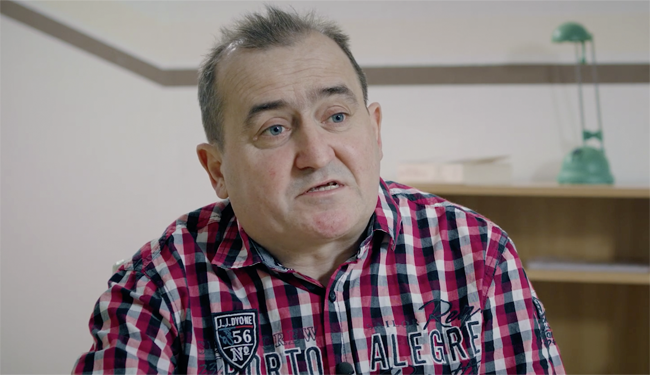VENTRICULAR SEPTAL
DEFECT OCCLUDERS
STRUCTURAL INTERVENTIONS
Ventricular septal defects (VSDs) are the most commonly found congenital
heart defect.2 Our Amplatzer™ VSD portfolio includes occluders specifically
designed to close complex VSDs in patients considered to be too high risk for
standard surgical repair.
The importance of treating patients with VSD

AFTER RECEIVING THE AMPLATZER™ VSD OCCLUDER JOZEF, AMAZED AT HIS ENERGY AND ABILITY TO WALK LONG DISTANCES AGAIN, SAID:
“I feel joy deep inside me—inside my heart.”
*This testimonial relates an account of an individual’s response to the treatment. This patient’s account is genuine, typical and documented. However, it does not provide any indication, guide, warranty or guarantee as to the response other persons may have to the treatment. Responses to the treatment discussed can and do vary and are specific to the individual patient.
Amplatzer™ Muscular VSD Occluders
The Amplatzer™ Muscular VSD Occluder is indicated for use in patients with a complex VSD of significant size to warrant closure—large volume left-to-right shunt, pulmonary hypertension, and/or clinical symptoms of congestive heart failure—in patients who are considered to be at high risk for standard transatrial or transarterial surgical closure based on anatomical conditions and/or based on overall medical condition.
Benefits, ease of transcatheter closure of VSDs
“The benefits of avoiding [cardiopulmonary] bypass are intuitive, and the relative ease of placement makes this procedure ultimately attractive.”3
Both transcatheter and surgical closure are options for patients with moderate to large VSDs. In particular, physicians should perform VSD closure when the patient has2:
- Left ventricular (LV) volume overload and hemodynamically significant shunts, with pulmonary-to-systemic blood flow ratio (Qp/Qs) of 1.5 or higher*
- Worsening aortic regurgitation (AR) caused by perimembranous VSD
In patients whose VSD is not repaired, there is an increased risk of infective endocarditis (IE), usually involving the tricuspid and pulmonary valves.
A post-myocardial infarction muscular VSD is a life-threatening complication that often leads to cardiogenic shock.4 Notably, medical management alone is associated with a grim prognosis of a 94% mortality rate at 30 days.5
The Amplatzer™ Post-infarct Muscular VSD Occluder is a percutaneous transcatheter occlusion device intended for closure of post-myocardial infarction muscular VSDs in patients who are not satisfactory surgical candidates.6

Amplatzer was “Just the right device” for VSD
Cardiologist
Due to his VSD, Jozef developed endocarditis, which in turn led to heart failure and kidney failure. After receiving an Amplatzer VSD Occluder, Jozef, astonished at his symptom improvement, noted “I feel joy deep inside me—inside my heart.”
Hub
- Data on file at Abbott.
- Stout KK, Daniels CJ, Aboulhosn JA, et al. 2018 AHA/ACC Guideline for the Management of Adults with Congenital Heart Disease: a report of the American College of Cardiology/American Heart Association Task Force on Clinical Practice Guidelines. Circulation. 2019;73(12):e81-e192. doi: 10.1161/CIR.0000000000000603.
- Minette MS, Sahn DJ. Ventricular septal defects. Circulation. 2006;114:2190-2197.
- Schlotter F, de Waha S, Eitel I, et al. Interventional post-myocardial infarction ventricular septal defect closure: a systematic review of current evidence. EuroIntervention. 2016;12:94-102.
- Crenshaw BS, Granger CB , Birnbaum Y, et al. Risk factors, angiographic patterns, and outcomes in patients with ventricular septal defect complicating acute myocardial infarction. Circulation. 2000;101(1):27-32.
- Amplatzer Post-infarct Muscular VSD Occluder Instructions for Use.